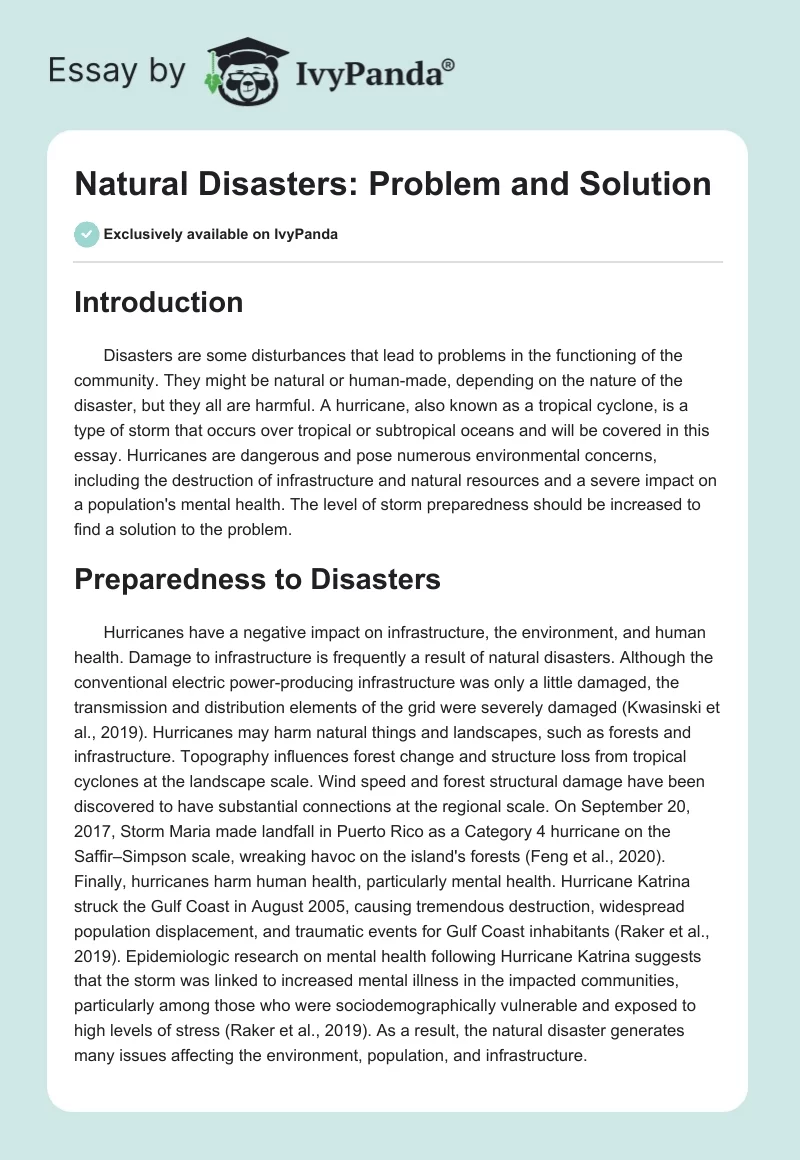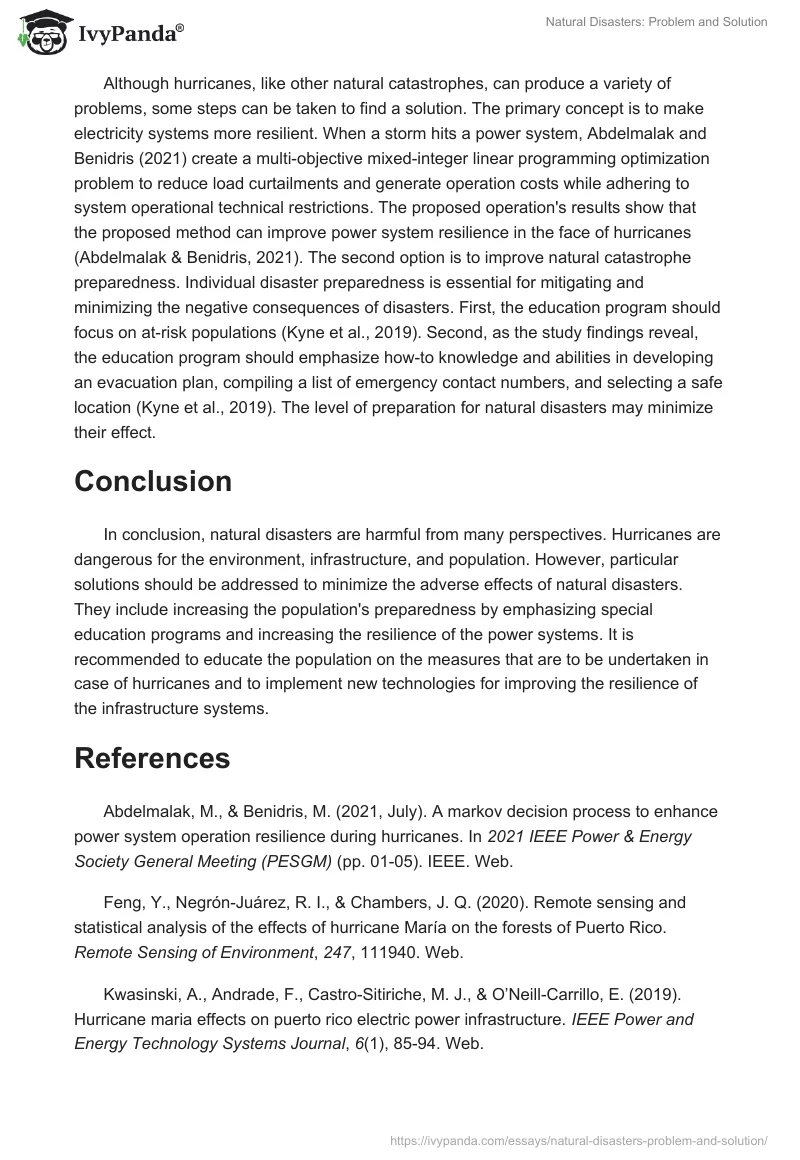Introduction
Disasters are some disturbances that lead to problems in the functioning of the community. They might be natural or human-made, depending on the nature of the disaster, but they all are harmful. A hurricane, also known as a tropical cyclone, is a type of storm that occurs over tropical or subtropical oceans and will be covered in this essay. Hurricanes are dangerous and pose numerous environmental concerns, including the destruction of infrastructure and natural resources and a severe impact on a population’s mental health. The level of storm preparedness should be increased to find a solution to the problem.
Preparedness to Disasters
Hurricanes have a negative impact on infrastructure, the environment, and human health. Damage to infrastructure is frequently a result of natural disasters. Although the conventional electric power-producing infrastructure was only a little damaged, the transmission and distribution elements of the grid were severely damaged (Kwasinski et al., 2019). Hurricanes may harm natural things and landscapes, such as forests and infrastructure. Topography influences forest change and structure loss from tropical cyclones at the landscape scale. Wind speed and forest structural damage have been discovered to have substantial connections at the regional scale. On September 20, 2017, Storm Maria made landfall in Puerto Rico as a Category 4 hurricane on the Saffir–Simpson scale, wreaking havoc on the island’s forests (Feng et al., 2020). Finally, hurricanes harm human health, particularly mental health. Hurricane Katrina struck the Gulf Coast in August 2005, causing tremendous destruction, widespread population displacement, and traumatic events for Gulf Coast inhabitants (Raker et al., 2019). Epidemiologic research on mental health following Hurricane Katrina suggests that the storm was linked to increased mental illness in the impacted communities, particularly among those who were sociodemographically vulnerable and exposed to high levels of stress (Raker et al., 2019). As a result, the natural disaster generates many issues affecting the environment, population, and infrastructure.
Although hurricanes, like other natural catastrophes, can produce a variety of problems, some steps can be taken to find a solution. The primary concept is to make electricity systems more resilient. When a storm hits a power system, Abdelmalak and Benidris (2021) create a multi-objective mixed-integer linear programming optimization problem to reduce load curtailments and generate operation costs while adhering to system operational technical restrictions. The proposed operation’s results show that the proposed method can improve power system resilience in the face of hurricanes (Abdelmalak & Benidris, 2021). The second option is to improve natural catastrophe preparedness. Individual disaster preparedness is essential for mitigating and minimizing the negative consequences of disasters. First, the education program should focus on at-risk populations (Kyne et al., 2019). Second, as the study findings reveal, the education program should emphasize how-to knowledge and abilities in developing an evacuation plan, compiling a list of emergency contact numbers, and selecting a safe location (Kyne et al., 2019). The level of preparation for natural disasters may minimize their effect.
Conclusion
In conclusion, natural disasters are harmful from many perspectives. Hurricanes are dangerous for the environment, infrastructure, and population. However, particular solutions should be addressed to minimize the adverse effects of natural disasters. They include increasing the population’s preparedness by emphasizing special education programs and increasing the resilience of the power systems. It is recommended to educate the population on the measures that are to be undertaken in case of hurricanes and to implement new technologies for improving the resilience of the infrastructure systems.
References
Abdelmalak, M., & Benidris, M. (2021). A markov decision process to enhance power system operation resilience during hurricanes. In 2021 IEEE Power & Energy Society General Meeting (PESGM) (pp. 01-05). IEEE. Web.
Feng, Y., Negrón-Juárez, R. I., & Chambers, J. Q. (2020). Remote sensing and statistical analysis of the effects of hurricane María on the forests of Puerto Rico. Remote Sensing of Environment, 247, 111940. Web.
Kwasinski, A., Andrade, F., Castro-Sitiriche, M. J., & O’Neill-Carrillo, E. (2019). Hurricane maria effects on puerto rico electric power infrastructure. IEEE Power and Energy Technology Systems Journal, 6(1), 85-94. Web.
Kyne, D., Cisneros, L., Delacruz, J., Lopez, B., Madrid, C., Moran, R., Provencio, A., Ramos, F. & Silva, M. F. (2020). Empirical evaluation of disaster preparedness for hurricanes in the Rio Grande Valley. Progress in disaster science, 5, 100061. Web.
Raker, E. J., Lowe, S. R., Arcaya, M. C., Johnson, S. T., Rhodes, J., & Waters, M. C. (2019). Twelve years later: The long-term mental health consequences of Hurricane Katrina. Social Science & Medicine, 242, 112610. Web.


